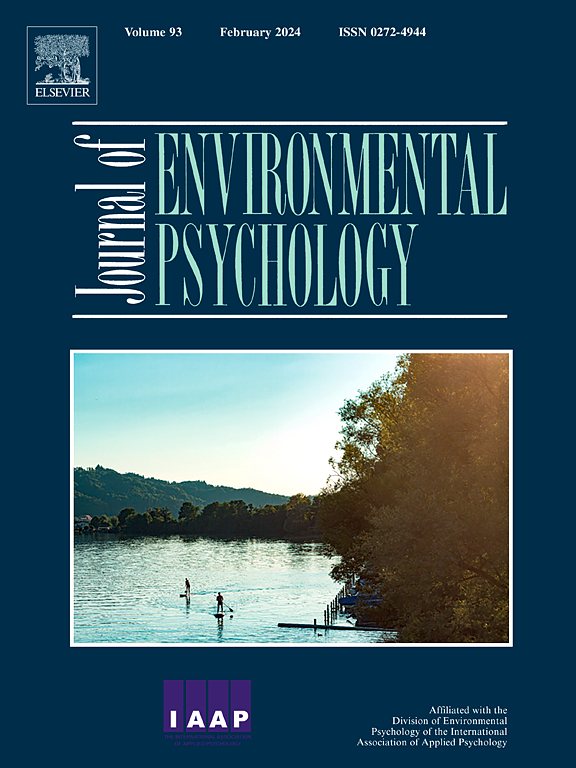城镇居民去哪里恢复?一种比较混合方法的研究心理体验的日常喜爱的室内和室外的城市场所
IF 7
1区 心理学
Q1 ENVIRONMENTAL STUDIES
引用次数: 0
摘要
考虑到世界上大多数人口的大部分时间都在城市环境中度过,提高对城市中心理恢复和更广泛的积极心理体验的选择的理解至关重要。目前的研究调查和比较了自我报告的恢复性体验和这些体验的特征,这些体验与活动的能力和社会背景有关,在广泛的城市自然和建筑环境中,包括室外(如公园、森林、蓝色空间,还有广场、街道、观点)和室内(如饮食场所、学习场所、博物馆、家)。这项研究是基于一项关于城市中人们最喜欢的地方的大型在线调查。我们在五个国家(澳大利亚、芬兰、荷兰、西班牙和英国)的六所不同大学招募了教职员工和学生;总n = 945)。我们量化和比较了自我报告的修复心理体验,并对不同地方类型的活动能力和修复背景进行了分类。分析基于统计测试和数据挖掘方法的结合。我们还提出了试点情绪分析的结果。我们发现,总体而言,户外场所在自我报告的心理体验方面得分高于室内场所,大约三分之二的受访者最喜欢的户外场所是自然环境。在室内的地方发现了更多的变化,在家里;饮食场所;而学习场所、大学建筑或自习室约占三分之二。尽管被提及的频率相对较低,但教堂和精神中心、体育场馆、博物馆、电影院和别人的家都是与自我报告的心理体验评分最高的室内环境。词频分析显示,心理恢复的主要特征是认知活动和社交活动——在不同的地方有所不同。虽然在户外环境中,快乐是受访者报告的主要情绪,但在室内环境中,情感体验的变化更多,也有信任和期待的报告。这项研究有助于超越“自然与建筑”的二分法,在特定类型的城市场所中检查修复的心理体验和影响。总体而言,研究表明,城市中的几种自然和非自然环境可以促进积极的恢复性和情感体验,并提供了这种体验的活动能力和社会背景特征的比较概述。本文章由计算机程序翻译,如有差异,请以英文原文为准。
Where do urban residents go to restore? A comparative mixed-methods study on psychological experiences in everyday favourite urban indoor and outdoor places
Improving understanding of options for psychological restoration and wider positive psychological experiences in cities is crucial, considering that the majority of the world population spends most of their time in urban settings. The current study investigates and compares self-reported restorative experiences and features of these experiences related to activity affordances and the social context in a wide range of urban natural and built settings, including both outdoor (e.g., parks, forests, bluespace but also squares, streets, viewpoints) and indoor places (e.g., eating and drinking places, study places, museums, the home). The study is based on a large online survey on favourite places in cities. We recruited staff and students at six different universities in five countries (Australia, Finland, the Netherlands, Spain, and the United Kingdom; total n = 945). We quantify and compare self-reported psychological experiences of restoration and classify activity affordances and the context of restoration across place typologies. Analyses are based on a combination of statistical tests and data mining methods. We also present results from pilot sentiment analyses. We found that overall outdoor places scored higher than indoor places in self-reported psychological experiences, and around two-thirds of respondents' outdoor favourite places were natural ones. More variety was found among indoor places, with the home; eating and drinking places; and study places, university buildings or study rooms constituting together around two-thirds of responses. Despite relatively infrequent mentions, churches and spiritual centres, sports venues and, partially, museums, cinemas, and someone else's home were the indoor settings associated with greatest self-reported ratings of psychological experiences. Word frequency analyses showed that psychological restoration was mostly characterised by cognitive activities and socialisation – with variation among places. While in outdoor environments joy was the dominant emotion reported by respondents, in indoor places there was more variation in the emotional experiences with also trust and anticipation reported. This study contributes to going beyond the ‘nature versus built’ dichotomy in the examination of psychological experiences of restoration and affect in specific typologies of urban places. Overall, it shows that several natural and non-natural environments in cities can promote positive restorative and emotional experiences and offers a comparative overview of the activity affordances and social context features of such experiences.
求助全文
通过发布文献求助,成功后即可免费获取论文全文。
去求助
来源期刊

Journal of Environmental Psychology
Multiple-
CiteScore
10.60
自引率
8.70%
发文量
140
审稿时长
62 days
期刊介绍:
The Journal of Environmental Psychology is the premier journal in the field, serving individuals in a wide range of disciplines who have an interest in the scientific study of the transactions and interrelationships between people and their surroundings (including built, social, natural and virtual environments, the use and abuse of nature and natural resources, and sustainability-related behavior). The journal publishes internationally contributed empirical studies and reviews of research on these topics that advance new insights. As an important forum for the field, the journal publishes some of the most influential papers in the discipline that reflect the scientific development of environmental psychology. Contributions on theoretical, methodological, and practical aspects of all human-environment interactions are welcome, along with innovative or interdisciplinary approaches that have a psychological emphasis. Research areas include: •Psychological and behavioral aspects of people and nature •Cognitive mapping, spatial cognition and wayfinding •Ecological consequences of human actions •Theories of place, place attachment, and place identity •Environmental risks and hazards: perception, behavior, and management •Perception and evaluation of buildings and natural landscapes •Effects of physical and natural settings on human cognition and health •Theories of proenvironmental behavior, norms, attitudes, and personality •Psychology of sustainability and climate change •Psychological aspects of resource management and crises •Social use of space: crowding, privacy, territoriality, personal space •Design of, and experiences related to, the physical aspects of workplaces, schools, residences, public buildings and public space
 求助内容:
求助内容: 应助结果提醒方式:
应助结果提醒方式:


